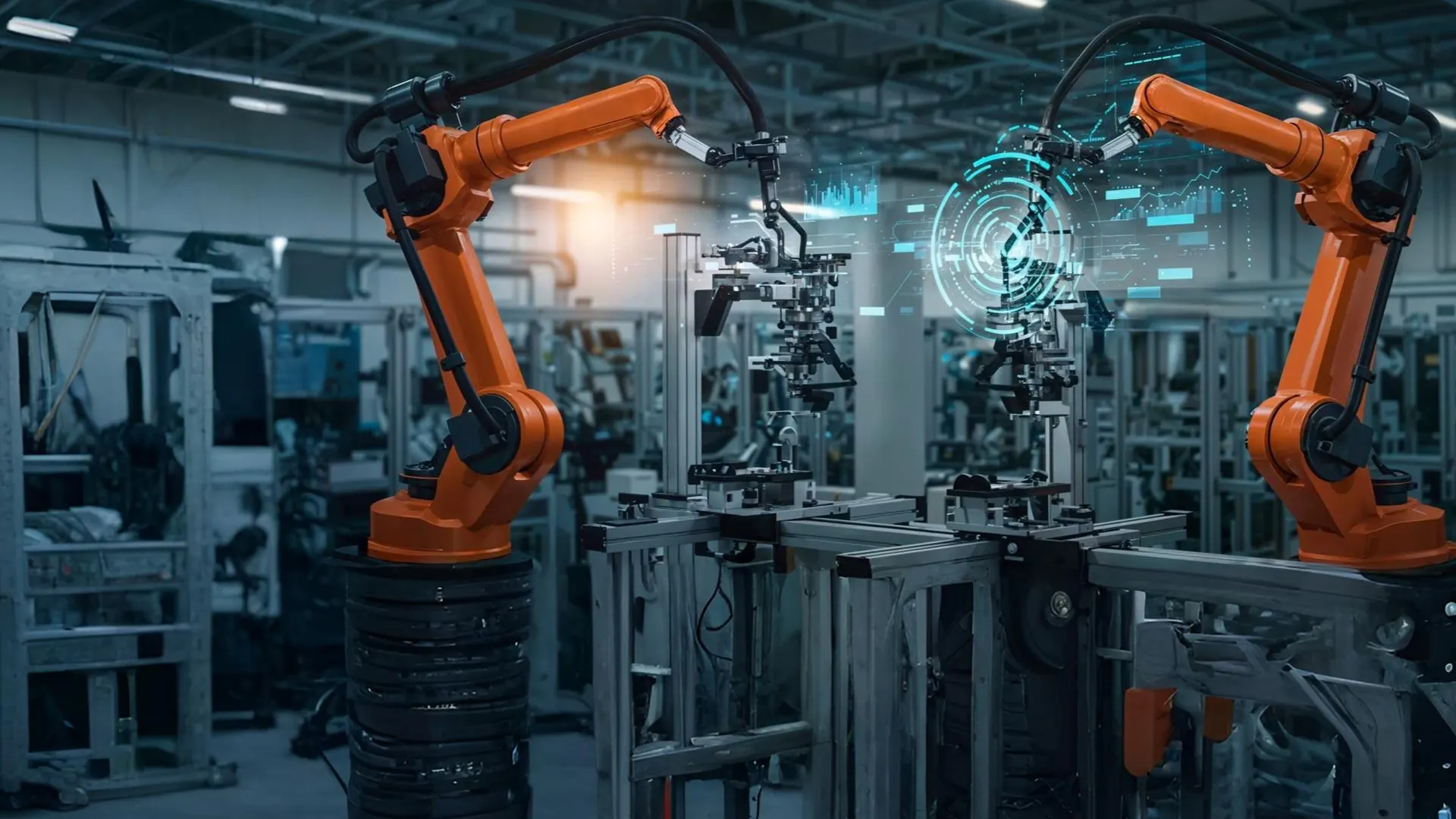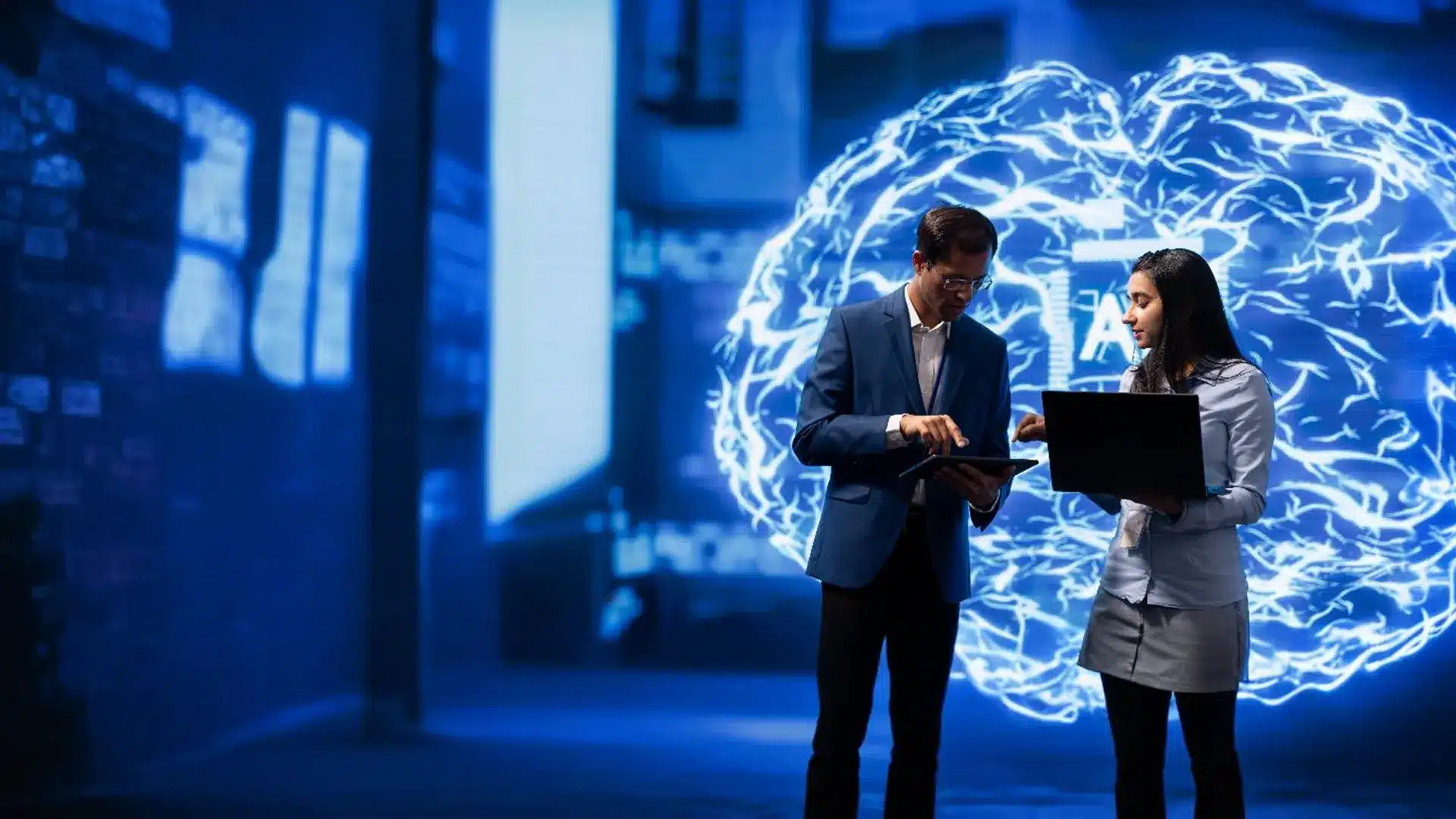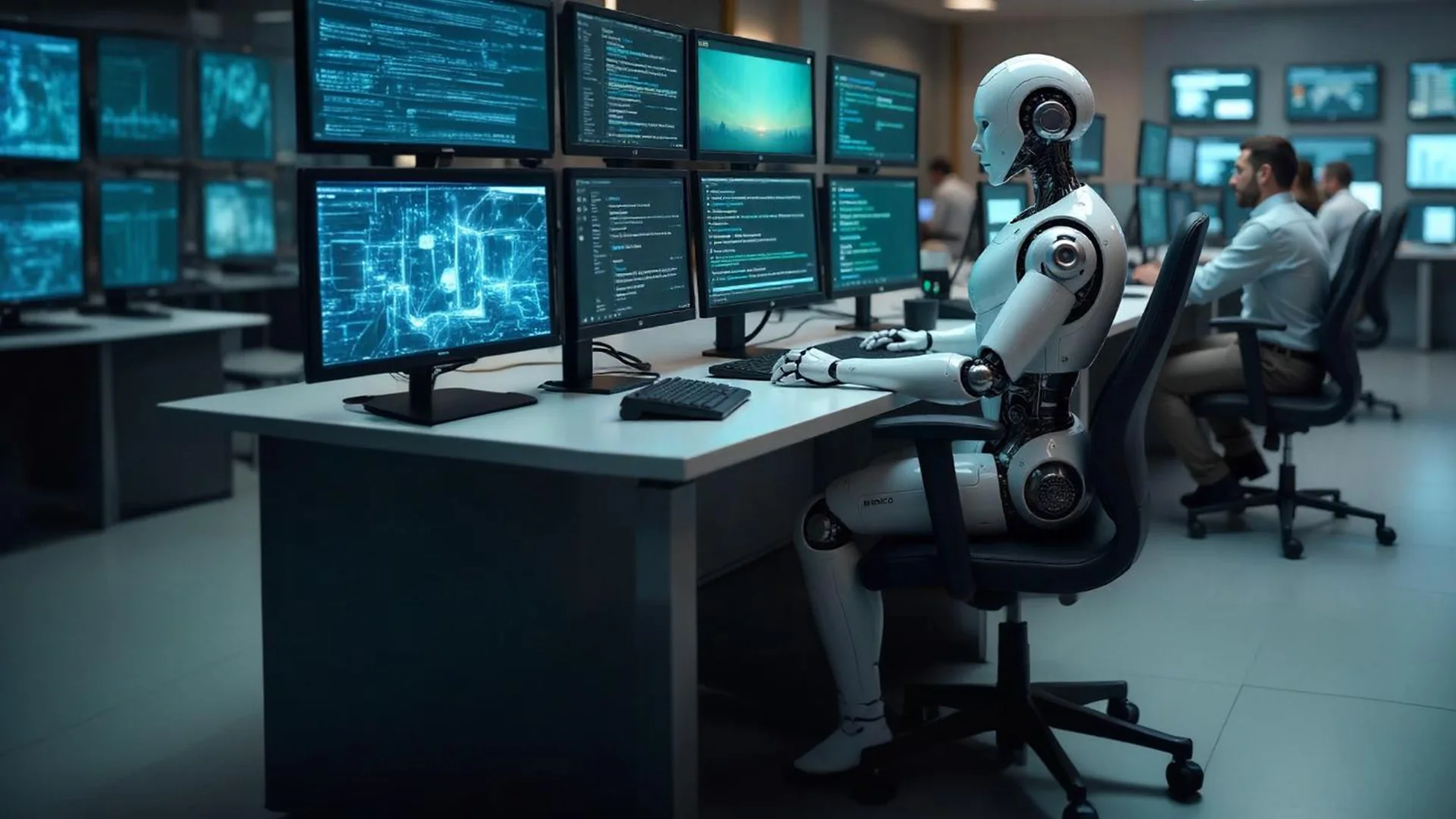AI use cases in manufacturing have transformed the way this industry operates and evolves. While the traditional approach only resulted in the wastage of inventory and resources, AI applications in manufacturing provide predictive analysis capabilities that help businesses to predict the inventory demand in the market and make smart decisions. Integrating technologies like machine learning, natural language processing, and computer vision has allowed the manufacturer leaders to increase efficiency while eliminating the chances of human errors.
According to statistics, 72% of companies that invest in Industry 4.0 technologies believe that AI will reduce their operational costs while enhancing operational efficiency. If you are a manufacturing business owner but still rely on outdated manual processes, there are high chance that your competitors are going to outperform you very soon. To make sure that such things never happen, give a read to this article that will guide you about how is ai used in manufacturing to achieve competitive advantages and increase revenue.
What Is AI in The Manufacturing Industry?
AI in manufacturing industry is a strategic process of implementing robust technologies like artificial intelligence, machine learning, natural language processing, computer vision, and much more in the operational process of a manufacturing firm. The core goal of this process is to automate repetitive tasks, increase production, enhance efficiency, eliminate errors, and thus skyrocket revenue.
Manufacturing is a big and complex process that requires the contributions from many other sub-tasks like inventory supply, machinery maintenance, material sourcing, understanding market trends, aligning customer expectations, and a lot more. Artificial intelligence helps the manufacturing business owners to take control of all these tasks by analyzing the historical data, and thus take better, and result-driven decisions.
AI in Manufacturing Market Size
Most of the big manufacturers around the world are relying on artificial intelligence to scale their operations while removing discrepancies from the process. Whether it is understanding market trends or controlling the inventory size, AI is playing a core role in every part. Let’s understand how AI applications in manufacturing are transforming the scenario with the help of some insightful numbers-
- According to research, 39% of manufacturing and production businesses have begun the adoption of AI. This market share is bigger than any other industry.
- As per the statistics, the AI in manufacturing market size is increasing with a compound annual growth rate of 37.7%, which will result in the market size of $695.16 billion by 2032.
- According to a survey, 41% of the manufacturers have reported improvements in their process optimization and control after deploying AI.
- At the same time, 51% of the respondents from the survey have agreed that their operational visibility and responsiveness have increased after deploying AI technology.
- According to Statista, 59% of manufacturers around the world believe that artificial intelligence helps in quality control during the manufacturing process, while 44% believe that inventory management is the biggest benefit of AI applications in manufacturing.
- 47% of the manufacturer respondents from a survey plan to deploy AI customer-facing tools within the next 2 years to enhance their customer experience.
10 AI Use Cases in Manufacturing in 2025
Whether it is AI for predictive maintenance in manufacturing or using innovative technology to enhance the productivity of the workforce, there is a range of AI use cases in manufacturing. We have monitored the industry and conducted in-depth research to identify how AI is used in manufacturing. Let’s explore them here-
1. Warehouse Management
For any manufacturing unit, warehouse management is one of the most crucial tasks that allows companies to save on rent, ensure a smooth supply chain, and manage the spaces in their warehouses. The use of AI in the manufacturing industry integrates machine learning capabilities to help in analyzing the market trends and thus manage the inventory levels. It assists in properly utilizing the space in a warehouse while automating tasks and enhancing overall efficiency. Additionally, the smart system keeps track of inventory incoming and outgoing, along with shipment dates, to provide insights into available slots in the warehouse.
2. Supply Chain Management
Similar to the warehouse, supply chain management also becomes easy by implementing AI applications in manufacturing. For example, the predictive analysis capability allows manufacturers to order the raw material in the right quantity. In parallel, it also analyzes the hot-selling areas where the maximum supply is needed. All these analysis enables the manufacturing business owners to establish a streamlined supply chain with advanced supply chain software development solutions that takes care of raw material sourcing and final product shipment without compromising the deadlines. Also, AI systems are trained to identify the errors in the supply chain that bring cost efficiency.
3. Cobots
Cobots or Collaborative Robots are extensive AI solutions that are designed to work in the manufacturing industry just like the human workforce. The innovative robots are efficient for handling the physical tasks as well as fostering autonomous decision-making. For example, cobots can be used for the packaging of products with much speed as compared to the human workforce. At the same time, these robots can also be trained to monitor the functioning of machines to identify the issues and inform the authorities. Many big brands like Amazon are already using cobots for a range of tasks like order processing, logistics management, fulfillment, invoice generation, operations optimization, and much more.
4. Predictive Maintenance
As previously interpreted, mechanical breakdowns are one of the biggest cost factors for business owners. Moreover, a sudden failure in the machinery also delays production. So, an artificial intelligence solution keeps track of the maintenance schedule of all the resources in a manufacturing unit and alerts the authorities whenever there is a need to repair. In parallel, it also monitors the functioning of these machines to identify unusual noises, discrepancies, fuel consumption, etc. This capability helps to assess the minor defects and repair them before they turn into a big mechanical failure.
5. Product Development
We have tonnes of examples where the companies were outperformed by their competitors only because they could not understand the changing customer expectations and design the product accordingly. AI use cases in manufacturing bring a solid solution to this challenge as machine learning implementation allows businesses to understand their customers’ expectations, changing market trends, and competitors’ movements. This analysis helps in better and more innovative product development that can align with changing customer expectations. So, AI is playing a big role in new product development.
6. Enhanced Performance
Whether the performance is associated with the mechanical resources or the human resources, AI is a catalyst for both. While it allows machines and non-living resources to work on their maximum potential, AI also enables human resources to automate unproductive and repetitive tasks and focus more on strategy building and brainstorming. At the same time, AI can also assess the present time approach to identify the possible challenges in the future. Thus, it becomes easier to craft the mitigation strategies that ensure that any challenge doesn’t impact the manufacturing quantity or quality.
7. Quality Assurance
AI is highly helpful for manufacturing businesses to maintain the highest quality standard of their products. First of all, it analyzes the overall manufacturing chain to check for issues and provides personalized recommendations to make improvements. The implementation of computer vision technology makes it easier to keep a keen eye on the product and check for any damage, tears, or appearance issues. So, any item with such an issue is discarded before the final products get shipped. Meanwhile the pre-trained AI model makes it very easy for the business owners to match the final product with set quality standards.
8. Transparent Workflow
Manufacturing businesses have to operate with several partners and stakeholders. Thus, it also requires different formalities and paperwork, which consumes a lot of time. Thus, AI applications in manufacturing facilitate the robotic process automation that automatically sends the relevant paperwork to authorities, gets it checked and signed, reminds the stakeholders of sending or reviewing the papers, and much more. Be it sending the invoices, receiving orders, or collecting feedback, the overall interaction process can be streamlined with AI.
9. Order Management
In the era of globalization, where the business is not influenced by boundaries, it has become challenging for manufacturing businesses to meet the order demand from across the world. At the same time, it has also to be ensured that an optimum inventory level is available, transportation partners are informed, and order is received and shipped efficiently. However, artificial intelligence makes this whole process much easier by automatically processing orders, checking on inventory levels, connecting with transportation partners, sending them the required details, etc. Additionally, it can also prioritize the order based on urgency, order size, location, past relation, etc.
10. Labor Safety
According to the International Labour Organization, approximately 3 million workers die every year due to work-related injuries and accidents. AI in the manufacturing industry is now working tremendously to bring this number down. Artificial intelligence helps in implementing different safety practices to avoid such accidents. For example, it makes sure that any worker has not consumed alcohol before starting the work, everyone has their safety gear on, and sufficient training related to the work has been provided. At the same time, it can even turn off the machines and alert the authorities whenever any injury or accident is reported.
7 Benefits of Using AI in manufacturing
AI in manufacturing companies not only provides operational benefits to the businesses but also ensures financial advantages. Whether it is automating the tasks with the help of technology or fostering better resource utilization to ensure the maximum production, artificial intelligence ensures that things are working at their best potential. At the same time, it reduces the need for infrastructural development, which makes the manufacturing process more cost-efficient. Here are the core benefits of AI in manufacturing-
1. Better Product Quality
As stated in the statistics section, product quality control is one of the biggest benefits that can be achieved with the implementation of AI in the manufacturing industry. Artificial intelligence helps business owners assess the root cause of product quality issues, provides real-time recommendations to make improvements, and thus contributes to enhancing the overall product quality. At the same time, the computer vision technology analyzes the entire product and makes sure that any defective piece is not supplied to the market, maintaining the prestige of the brand.
2. Data-Driven Decision Making
With AI applications in manufacturing, it becomes extremely easier for the business owners to assess large volumes of data to make the best decisions. For example, a clothing brand owner can predict the upcoming demand for summer clothes by analyzing their historic sales data in that particular season. So, they can plan the manufacturing so that it saves money, raw material, manufacturing costs, and warehouse space. Similarly, it also helps to identify the customer’s expectations so that manufacturing business owners can produce the relevant products.
3. Cost Efficiency
There are numerous methods through which AI brings cost efficiency into manufacturing businesses. First of all, it automates the repetitive tasks and performs them within minutes, which used to take days and even months. This saves the human resource cost for the businesses. Moreover, there is no chance of inaccuracy, which ensures the transparency and reliability of the business process. By providing insights into the market demands and controlling the manufacturing accordingly, it prevents the business owners from investing unnecessarily in raw materials. It increases the overall production efficiency of the firm, which leads to increased revenue.
4. Predictive Maintenance
According to the research, the maintenance and repair of the manufacturing machines is one of the biggest costs that manufacturers have to bear. So, using AI in manufacturing reminds the relevant authorities of the timely maintenance of machines so that resources work at their maximum capacity without burning unnecessary fuel. At the same time, AI is capable of identifying unusual working patterns or noises in the machines and reporting them to the relevant authorities. It helps to repair the machine before any big malfunction or incident happens.
5. Customization
There is no doubt that customers are rapidly turning towards customized products. Even the big brands like Nike provide the customization option where the customers can design their shoes by choosing the colors, textures, and fabrics. Artificial intelligence helps the facturing businesses collect insightful data about their customers’ preferences. This data is then processed further to transform it into the designs that they might like. Simultaneously, AI also analyzes social media platforms and user-generated content to understand their interests and impart customization in the manufacturing process.
6. Better Customer Service
This is one of the biggest benefits of implementing AI in the manufacturing industry. The robust technologies bring automated and smart chatbots that provide 24*7 assistance to customers. By analyzing the specific keywords, these digital assistants can provide the right information to the customers. At the same time, it can also connect the user to concerned authorities. Advanced agentic AI solutions are even capable of automating the entire tasks without relying on human input. Chatbots can be used to collect customer feedback, register complaints, provide information about transactions, process refunds, etc.
7. Competitive Advantages
While AI is burgeoning in the manufacturing industry, it can still provide huge competitive advantages to the business when implemented at the right time and in the right manner. Whether it is manufacturing high-quality products, offering around-the-clock customer support, or curating the products according to customer preferences, it strengthens the relationship between a brand and end-customer to bring competitive advantages.
2 AI Case Study Successes in Manufacturing
It’s no longer the scenario where we have to only perceive and predict AI use cases in the manufacturing industry. Several real-time manufacturing brands have implemented Artificial Intelligence into their operational process and have multiplied their efficiency along with their revenue. Let’s explore some case studies with AI implementation in manufacturing-
1. Nike
Nike is one of the biggest and most famous lifestyle and sports brands around the world. The company offers high-quality shoes and accessories that not only focus on comfort but also align with changing fashion trends in the market. However, the prominence of this brand is not driven by tradtioinal operational processes and plans. The brand has adopted AI to better connect with its customers while improving in their product designs.
a. Implementing AI in manufacturing
Nike has implemented generative AI in the manufacturing process that allows it to understand customer preferences and shape their products accordingly. In 2024, Nike’s chief innovation officer, John Hoke, conveyed that Nike is developing their own generative AI model that will be helping to design exclusive products by analyzing the athlete’s data. The technologies like machine learning, large language models, proprietary generative AI models, 3D printing, and computational designs will be integrated into the system. According to Hoke, this initiative is a part of Nike’s broader strategy that brings 3D printing and virtual reality to the forefront to revolutionize the manufacturing approach.
b. Personalized Customer Experience
Nike is one of the brands with the highest customer loyalty. For the same, Nike has been relying on AI technologies like data science, machine learning, and AI algorithms. The firm gathers consumer data from its apps, websites, supply chain, and enterprises. However, extracting the insights from this data was challenging, so a new strategy called the Nike Direct Strategy was implemented. Several data analyst firms, like Datalogue, were acquired to get the required information from the data. After that, the company implemented AI that recorded the buying behavior of customers to suggest them relevant products and enhance their overall shopping experience.
2. Bosch
Bosch is a leading electronic appliances manufacturers that supplies washing machines, tumble dryers, refrigerators, freezers, ovens, stoves, dishwasher, and many more all around the world.
a. Quality Management with Big Data and ML
The company has reported that it uses big data and machine learning technologies to manage and enhance its product quality while optimizing the overall manufacturing operations at its plants located at different locations. The smart system ensures that each manufactured unit aligns the pre-defined quality standards by Bosch and only then is shipped to the market.
b. AI for Predictive Maintenance
The company also leverages deep learning techniques to automate optical inspection, identify the root cause of machinery failures, detect anomalies, and schedule production. Moreover, Bosch uses the VisionSmart AI that helps the company to detect the defects at micro level, reduces the inspection time, and improve the overall manufacturing accuracy. Using generative AI in manufacturing, they also generate synthetic images of defects, which are then used to train the model to detect similar defects more reliably.
3 Challenges of AI Implementation in Manufacturing
There is no doubt that implementing AI in manufacturing can be a great idea, but it is also associated with a range of challenges. While AI is driving the leading brands and their operations, finding the right artificial intelligence development company for manufacturing is the most important part to leverage the benefits and mitigate the challenges. Here are some of the core challenges and problems faced during AI implementation in the manufacturing industry-
1. Complex Integration with Existing Legacy System
Integrating the new AI solution into the existing legacy system is still a big challenge due to the limited AI experts in the market. There might be many reasons, like limited adaptability of the existing system to integrate the new solutions, unscalable technological architecture, and more. At the same time, if the new solution is not integrated into the legacy system, employees might not be able to leverage the benefits to the fullest.
Solution
Different integration platforms and APIs can be used to streamline the integration process between a new AI solution and an existing technological architecture. The use of the right API helps in seamless data exchange that increases the AI use cases in manufacturing.
2. Scalability and Adaptability to Change
AI requires a good investment in the beginning, and thus, it is very important that it is scalable according to changing business needs. However, ensuring the scalability of AI solutions is a big challenge as different departments and teams have their unique operational needs. Thus, there are huge chances that an AI solution might compromise versatility at some point.
Solution
A scalable AI system with integration of cloud platforms has to be deployed that can bring collaboration between different teams and encourage versatility.
3. Lack of Quality Data
The efficiency of AI applications in manufacturing depends hugely on the data quality and quantity used for the training. However, it is a challenging and complex task to arrange the huge amount of data. At the same time, fine-tuning the data to eliminate impurity and incorrect details is also important, as low-quality data might drive the AI solutions to provide biased results.
Solution
To make sure that only high-quality data is processed for the training, automated data clearing and transformation processes are deployed that ensure that the overall data carries the correct information.
How to Implement AI in Manufacturing?
There is no doubt in the statement that AI implementation in the manufacturing industry streamlines the operational process while increasing production efficiency. However, it is important to implement the right AI solution according to the real-time business challenges and requirements. At the same time, the implementation process also has a significant role in determining the efficiency and success of an AI solution for a manufacturing firm. While the exact development approach might differ according to business requirements, here are the ideal stages for implementing AI in manufacturing-
1. Requirement Analysis and Identification
First of all, make sure that you have a clear vision of the pain points and key challenges that your business is facing. It will help you to ensure the right AI solution that can bring an effective strategy to fill the void and increase efficiency. For example, if there is a big problem in the inventory management, an AI-based predictive analysis software will be the right solution that can forecast the inventory demand and control the production accordingly.
2. Data Gathering and Fine-Tuning
As interpreted in the earlier section, it is important to gather the data from the right sources and optimize it for the training of the model. The second phase of AI implementation in manufacturing is dedicated to this task. In this step, our team of manufacturing AI developers focuses on collecting and purchasing data. Once the right amount of data is available, the team focuses on fine-tuning the information. It includes structuring the data, removing the irrelevant information, and ensuring the correctness.
3. Core Development and Deployment
As the name suggests, the third stage focuses on building the AI solution. It includes building the frontend and backend of the application, integrating the required APIs, designing the user interface, integrating the features, training the AI model, and much more. However, pilot projects are also conducted where the AI solution is developed and deployed at a small scale to check the efficiency. The pilot program also allows for analyzing the ROI of AI applications in manufacturing.
4. Workforce Training
Automating the workflow by implementing AI solutions in manufacturing might be challenging to adopt for the workforce, which has only engaged in manual operations. So, the fourth step is dedicated to providing he training to the workforce so that they can use the new AI solution to automate tasks, enhance accuracy, and increase their productivity. At the same time, the effective collaboration between human resources and AI solutions always plays the lead role in achieving the business goals.
5. Monitoring and Optimization
There might be errors and bugs at the early deployment stage, and thus, there is a need for technical support. It helps to monitor the performance of AI applications in manufacturing and ensure that everything is working according to plan. At the same time, post-deployment support also helps to remove bugs, add new features, and provide periodic updates to the solutions. It makes sure that the AI system stays versatile to changing business and customer needs.
Cost to Build AI Solutions in the Manufacturing Industry
An AI solution for manufacturing can be developed for $50,000, but an advanced solution might even require an investment of more than $500,000. It indicates that the AI development cost for the manufacturing industry is highly variable. The exact development cost depends on a range of factors, which include-
1. Project Complexity
The complexity of an AI development project is directly proportional to the development cost. For example, building an AI chatbot will be much cost cost-efficient as compared to building complex agentic AI solutions that can make autonomous decisions. The advanced AI solutions require machine learning integration, high-quality and quantity data, increased time, multi-layer interactions, and complex integration. All these factors contribute toward the AI development costs.
2. Data Sourcing
Different data sources are used to collect information. While some of them provide the information for free, most of the sources that provide high-quality data charge a fee. So, data acquisition cost is a big part of an AI development project. Furthermore, even after collecting the data, it requires a thorough fine-tuning process, which can eliminate incorrect details and bias in the data. The fine-tuning process requires additional resources, which adds to the dollars to development costs.
3. User Interface and Design
The customization of the user interface and design might increase the development cost. While an experienced AI development company like The NineHertz offers a seamless and easy-to-use interface free of cost with the development services, integrating the interactive elements and design customization might add to the overall development costs.
4. Location of Development Team
It might sound strange, but the location of the development team is one of the biggest factors that influence of AI development cost of manufacturing businesses. For instance, hiring the manufacturing AI developers from Western countries like the USA, UK, Australia, and Europe will cost you more than twice as compared as hiring the developers with the same expertise from an Asian country like India.
5. Integrations
Whether it is technological integration or third-party integration, both contribute equally to the development cost of AI solutions in manufacturing. For example, if the AI solution requires integration of machine learning, computer vision, natural language processing, or any of the relevant technologies, it will add to the dollars to final bill. Similarly, integrating the third-party APIs also contributes toward the development costs.
6. Project Timeline
Most of the development team deploys the hourly hiring model, which calculates the development costs according to the time spent by a team working on the project. So, the timeline of the overall AI development project contributes significantly toward determining the exact development costs. The basic development projects require less time and thus are cost-efficient. Similarly, the complex tasks take more time to complete and thus become expensive.
7. Maintenance and Update
In order to ensure that the final AI applications in manufacturing perform seamlessly and the periodic updates are deployed, it is important to opt for post-deployment support from an experienced AI development company. However, the post deployment support is also associated with several costs.
Estimated Costs based on Development Stages
| Discovery and Planning | 10–15% of the total cost |
| Data Preparation | 15–25% of the total cost |
| Model Development | 30–40% of the total cost |
| Deployment | 10–15% of the total cost |
| Maintenance and Scalability | 10–20% of the total cost |
Future of AI in Manufacturing
AI use cases in manufacturing have undoubtedly transformed the scenario, but there is still a lot to come. Just like mobile apps and software changed the way we perceive things in our lives, AI is going to redefine the way particular tasks are carried out and what role human resources will play in the future. Let’s have a glance at what the future might look like with AI applications in manufacturing.
1. Hyper Automated Operations
At the current stage, AI is mostly used to assist the human workforce to help them better and quickly analyze the information and make decisions. However, in the coming time, it is expected that AI will completely automate the repetitive tasks, which will free the workers from certain areas so that they can focus on more crucial things.
2. AI-Driven Factories
In the future, the AI might not be limited to just tasks, but it will be capable of managing the entire manufacturing units, while automating and optimizing different tasks like inventory management, supply chain management, and warehouse management. The fully autonomous decision-making environment will bring the accuracy and enhance the operational efficiency.
3. Digital Twins for Simulation
In the current scenario, we have to invest in the physical assets to check the efficiency and return on investment. However, bringing AI to manufacturing will allow the digital twins for simulation and optimization, where the AI will be creating highly detailed replicas of physical assets that will help to predict performance. It will accelerate the innovation speed and drive better decision-making.
How can The NineHertz help you?
Embracing the AI benefits in manufacturing is only possible when you partner with the right AI development company. The reason behind the statement is that an inefficient development partner might not be able to understand your vision and requirements to shape a digital product accordingly. At the same time, it might waste your time and financial resources as well.
The NineHertz is a leading AI development company with 15+ years of experience building scalable digital products for manufacturing businesses. We have partnered with businesses from different industries and maintained a client retention rate of more than 90%. The following are our core competencies that allow us to help manufacturing businesses embrace AI technology.
- First of all, we offer a free consultation session where our experts collaborate with the clients to understand their real-time requirements and challenges. The assessment helps to choose the right AI solution along with project timeline and required resources.
- We respect the privacy of information related to our clients and projects. So, we keep the Non-Disclosure Agreement at the center of the process that guarantees the confidentiality of information.
- The NineHertz has a long experience in digital product development, which allows us to save cost throught the development process without compromising the overall project quality.
- We are partnered with different sizes, and thus we offer multiple hiring models and cost brackets.
- The NineHertz understands the first mover advantages and thus we ensure the least time-to-market. It means, we develop and deploy the AI solutions in manufacturing within the least time frame.
- Our team provides ample maintenance and support after the deployment of software that promises seamless performance, periodic updates, and scalability of the solution.
- We ensure to understand and comply with regulatory standards, industry standards, and legal compliance.
Conclusion
Just like every other industry, AI in manufacturing is also making a buzz around the market for its capability in predictive maintenance, stock optimization, trend analysis, and process automation. While the technology is helping businesses to avoid unnecessary investment in brick-and-mortar infrastructure, it is steering the business towards digital investments that open up the door to increased revenue, streamline workflow, and enhance business operations.
If you are looking for an AI development company that can help you build a smart AI solution for your manufacturing firm, sign up for a free consultation with our experts and kick-start your new journey.
Frequently Asked Questions (FAQs)
How Is AI Used in Manufacturing?
Answer- There are numerous ways that AI is used in the manufacturing industry. For example, it is used to automate tasks to save time and increase accuracy. At the same time, predictive maintenance helps to identify the mechanical issues in the machineries and alert for the repairs. The AI trend tracker helps to understand market trends and product demands to manage the inventory levels.
What Is the Future of AI in Manufacturing?
Answer- AI is expected to bring a lot of new advancements and innovation in the manufacturing industry. For example, the digital twin technology will help to encourage precise manufacturing and streamline problem diagnosis. At the same time, it will create an exact replica of physical assets to check the efficiency and ROI.
How Much Does It Cost to Build AI Applications in Manufacturing?
Answer- The cost of AI development in manufacturing might range from $50,000 to $500,000. The exact development cost depends significantly on a range of factors like project complexity, third-party integration, location of development team, data availability, type of AI model, and much more.
How Much Time Does It Take to Develop an AI Solution for The Manufacturing Industry?
Answer- The timeline of AI development for the manufacturing industry might range from 6-12 months. Just like the cost, the exact timeline is also influenced by a range of factors like team size of developers, complexity of project, customization, UI design, third-party integrations, platform of development, etc.














